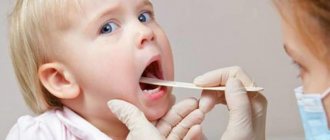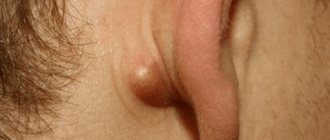Wreath on the bridge of a baby's nose
Children aged several months have very thin and delicate skin. Not surprisingly, veins can be visible through it. Doctors believe that this does not indicate danger, unless we are talking about trauma after childbirth. In the future, when the skin becomes thicker, the vein will not be visible, and the color of the bridge of the nose will return to normal.
A blue wreath on the bridge of a baby’s nose may also indicate an individual skin characteristic. In such children it may appear even after they reach one year of age.
The child's nose turns blue
Did you know that more than half of newborns and infants in their first year of life have marks on their skin that prove that they were carried by a stork and kissed by an angel? This beautiful fairy tale is supported by various spots on the face and neck of newborn children.
Internet forums dedicated to the problems of motherhood and childhood are full of questions about where babies get these spots, in particular the blue spot on the bridge of the nose.
Mothers vying with each other to say that from the very birth their children have such a spot that turns the bridge of their nose blue. This spot becomes even more visible when stressed - sneezing, crying, etc.
For some babies, a blue spot on the bridge of the nose does not appear at birth, but a month or two later. A slight blue tint appears closer to the corners of the eyes.
How can this be explained?
Children, as you know, have extremely delicate and thin skin. And therefore it is not surprising that capillaries, wreaths, and vessels can be seen through it.
Neurologists, to whom mothers show their babies, believe that, most likely, there is nothing terrible in this phenomenon if we are not talking about any kind of birth or postpartum trauma. This is just a vessel that is located very close to the surface of the skin.
When tension occurs, blood flow increases and the vessel becomes more visible through the baby’s thin, delicate skin.
The assumption that the blue bridge of the nose is simply a consequence gives mothers the right not to worry about this - with age, the child’s skin thickens and “covers” the blue.
Doctors have another version. Sometimes they make a diagnosis: the consequences of hypoxic ischemic damage to the central nervous system. In this case, treatment is prescribed and an ultrasound examination of the heart is performed.
Dear mothers, of course, a visible wreath in the bridge of the nose is the simplest and most reassuring explanation. However, you need to see a pediatric neurologist in any case. After all, there are other unpleasant things, for example, a tumor from blood vessels. She needs to be excluded.
In addition, any blue spot in the area of the bridge of the nose or nasolabial triangle should be carefully examined to exclude possible pathology in the child’s cardiovascular system. Based on the results, doctors will determine the advisability of additional examination and consultation with specialists in another field, for example, a cardiologist or surgeon.
Therefore, you shouldn’t panic at all, but you also shouldn’t ignore the blue bridge of your baby’s nose.
Wreath on the bridge of the nose on a baby
In the Children's Health section, to the question why is a wreath visible on the bridge of a child's nose? (now 4 years old, and she is almost from birth) the best answer given by the author Olmira is In the Caucasus they say that the next one born will be a boy))) I only succeeded the second time)))
The skin is thin, the blood vessels are close. I've been suffering from this all my life
it may be congenital. it will either go away with time or remain
Our child also has a wreath on the bridge of his nose since birth. The doctor said that it’s nothing to worry about, it’s just a feature.
Why does a child have a blue bridge of his nose?
A baby born is a long-awaited miracle that requires attention and care. And every mother tries to make every effort to make her child feel good.
Parents notice any changes in the baby’s condition, and if they are unclear, then fears cannot be avoided. Quite often, children notice the blue bridge of their nose.
And it would be quite useful to figure out why this phenomenon occurs and what concerned parents should do.
Actions
Of course, everyone would like the cause of the problem under consideration to be hidden in the anatomical and physiological characteristics of childhood. A wreath showing through delicate skin is the best explanation. But unfortunately, it is not the only one. And if suddenly the bridge of a child’s nose turns blue, dangerous conditions should first be ruled out.
Parents should not be too careless, but giving in to excessive anxiety is not the best option. Without a doctor's examination, it is unlikely that anything will become clearer.
Therefore, to resolve all issues, it is necessary to consult a pediatrician.
If the specialist does not reveal anything serious, then you can confidently and without fear continue standard care for the child, considering the blueness on the bridge of the nose to be a passing phenomenon.
But a completely different situation arises when, during the inspection, unpleasant facts are revealed that require further confirmation. The pathology identified by the doctor will require different approaches to treatment.
And parents, for whom the child’s health comes first, will need to follow all the specialist’s recommendations. But it is better to identify any problem at an early stage, because the success of therapy largely depends on this.
Therefore, the blueness on the bridge of the nose should at least be the basis for a trip to the children's clinic. And the doctors will figure out what to do next.
Wreath on the bridge of the nose
Has anyone else had the same thing and what is the reason for it? Is this a cause for concern and if so, which doctor should I contact?
Thanks in advance for your answers.
So, and you say why look, you can also say why go to the dentist, why get vaccinated, etc. etc. If it is discovered, then it is better to solve the problem early so as not to heal later (by the way, it is recommended to deal with headache problems for up to a year).
DOCTOR ANSWERS: Natalya Aleksandrovna Bichurina / 07/17:37
“This may be an individual characteristic of your child and a manifestation of intracranial hypertension, so you need to show the child to a neurologist to rule out hypertension (examination * NSG and ECHO-EG).”
All that remains is to find out what intracranial hypertension is and undergo an NSG for testing.
I wrote the doctor’s answer for those who are concerned.
Why does the bridge of the nose turn blue?
Cow's milk for babies - at what age can it be given?
The reasons for blueness of the bridge of the nose on the left or right side can be physiological and pathological.
Physiological features
Physiological causes of blue nose bridge include the following:
- Strong crying. It leads to breathing problems, which causes the level of oxygen in the blood to decrease.
- Fright.
- Feeding. The baby, sucking milk from the breast, makes an effort to do so. Due to this kind of stress, the blood vessels dilate and a characteristic bluish tint appears.
- Impact of mountain climate. For the baby, rarefied air is unusual, which the body reports by turning the skin blue.
- Often the bridge of a child's nose turns blue in the cold. This will go away as soon as the low temperature wears off.
Blueness of the bridge of the nose is also likely as a result of a fall; the baby can hit his head very often.
Bruise on the injured bridge of the nose
Important! When the bridge of a child’s nose turns blue and the skin color does not return for a long time, it is necessary to show the baby to a doctor. These symptoms may indicate the development of a serious illness.
Pathological causes
Depending on the cause, there are three types of pathological cyanosis of the bridge of the nose:
- Constant. Occurs against the background of a sucking disorder or after injury during childbirth, with high cranial pressure or due to the immaturity of the respiratory center.
- Pulmonary. Accompanied by pale skin and bruises under the eyes. Occurs due to pneumonia, bronchitis or asthma, diaphragmatic hernia, or foreign body entering the respiratory tract.
Attention! This type of blue discoloration of the bridge of the nose may occur due to the infant inhaling tobacco smoke.
- Cardiovascular. Blueness of the bridge of the nose sometimes appears as a result of pathologies of the cardiac septum, when listening to heart murmurs.
The risk of tumor formation developing from vascular tissue should not be excluded. The vessel at the base of the nose acquires an irregular structure during the prenatal period. The neoplasm is voluminous. It is soft to the touch and loses visibility when pressed.
What is hemangioma in an infant?
This is a benign tumor. It is often found in newborns up to one year old and has the appearance of a reddish or bluish formation. Sometimes such tumors are flat.
Hemangioma
Infants sometimes develop subcutaneous hematomas. Outwardly, they look like a small bruise on a newborn girl or newborn boy. Thanks to the gradual increase, parents can distinguish a tumor from a hematoma and consult a doctor in time.
Why does a child's nose turn blue?
Blue discoloration of the nasolabial triangle or cyanosis is an unpleasant symptom indicating improper functioning of the baby’s cardiovascular system. Normally, a child's nasolabial triangle should have the same color as the rest of the skin on the body. What causes this symptom and should parents sound the alarm when blueness is detected?
Immediately after birth, a slight blue discoloration may appear on the baby's nasolabial triangle. This type of cyanosis is called blueness of pulmonary origin.
This phenomenon occurs when a child screams or cries.
At this point, the oxygen level in the blood decreases and the skin turns blue. This type of cyanosis should completely disappear after the baby grows up, but if the cyanosis remains, then it should be shown to a doctor. You should not put off visiting a doctor, as cyanosis may indicate dangerous pathological conditions.
Causes
The blue color of the triangle may appear because the skin in this area is too thin. All the plexuses of veins are easily visible through it, so the fold appears blue. In this case, parents should not worry, since the symptom will disappear after the baby grows up and strengthens the skin.
Blueness of the nasolabial triangle at moments when the child is absolutely calm and does not cry should arouse suspicion among parents.
The most common cause of blue discoloration is congenital heart disease, acute heart failure, or pulmonary artery malformation. These pathological conditions can only be diagnosed by specialists, so the child should be immediately shown to a cardiologist.
Another cause of cyanosis can be any disease of the respiratory tract. When a child is diagnosed with pulmonary pneumonia or any other pathological condition of this organ, blanching of all skin covers is observed.
The baby's breathing worsens - it becomes heavy and intermittent.
If the attacks occur in an acute form, then blue discoloration may be noticeable on the nasolabial triangle. It may turn blue due to common respiratory problems.
In the first months of life, a child is vulnerable to any external factors, so even a runny nose can cause blueness. When the disease is completely cured, parents will be able to observe a change in the color of the nasolabial triangle from bluish to normal.
If a baby accidentally swallows a small part from a toy, the triangle may also turn blue. In this case, you should not hesitate, as the baby can easily suffocate. Parents need to call an ambulance, and doctors will remove the stuck part.
Diagnostics
To diagnose all conditions that cause cyanosis, an ultrasound of the child’s heart, a chest x-ray and a cardiogram are used. If the child does not have a heart defect, and the cyanosis does not go away, then he is sent for examination to a neurologist.
This specialist can diagnose insufficient or abnormal development of the respiratory system. As a treatment, parents are recommended to spend more time with the child in the fresh air, and also send the baby to therapeutic massage sessions. With the right approach, all symptoms disappear by the first year of life.
Treatment
Treatment of cyanosis of the nasolabial triangle largely depends on the reason for which it developed in the child. If a heart test reveals a patent foramen ovale but the valve remains, doctors will advise the parents on proper care for the child.
You need to take him for a lot of walks in the fresh air so that all the baby’s internal organs receive enough oxygen. Also, he should eat properly and be minimally stressed, since any nervous breakdown can lead to a heart attack.
When diagnosing the complete absence of a heart valve, it is difficult to do without surgical intervention. The child must be scheduled for a consultation with a surgeon, who will advise the parents on the type of intervention.
However, such serious manipulations can only be carried out on healthy and strong babies.
For weakened children, the date of surgery is postponed.
If there are no heart defects, the child is prescribed therapeutic massage, swimming and walks in the fresh air. They must improve the functioning of the respiratory system, which will subsequently lead to the complete disappearance of cyanosis.
Conclusion
Blue discoloration of the nasolabial triangle can occur during a disease of the cardiovascular or respiratory system, during infection with acute respiratory diseases, or due to lack of oxygen.
To protect your baby from the development of this unpleasant symptom, you need to follow the correct daily routine and provide him with a balanced diet.
Cyanosis of the nasolabial triangle can be prevented during pregnancy if the mother leads a healthy lifestyle.
Source: https://deti.medicalfirst.ru/pochemu-u-rebenka-sineet-perenosica/
When to contact a pediatrician
Rotavirus infection in a child under one year of age - symptoms and signs
Komarovsky explains that parents do not need to be careless, but they should not panic too much either. Without a medical examination, it is impossible to determine the cause of the blue bridge of the nose. When a blue bridge of the nose appears, parents should find out the following:
- how the baby grows and develops;
- does he have a heart murmur;
- whether he has a cough or difficulty breathing;
- whether blue discoloration appears in other parts of the body;
- whether the infant is sufficiently active or is getting tired;
- what skin color (dangerous if it is pale).
If you have even one doubt, you need to show your baby to a doctor.
Parents can rule out the presence of pathology based on the following signs:
- normal baby weight;
- mobility;
- absence of cough;
- normal color of skin and mucous membranes.
Sometimes, against the background of a change in the color of the bridge of the nose, the child may become nervous. His limbs or chin may tremble. Having noticed the appearance of such symptoms, there is no need to waste time, because these are the first signs of developing heart disease. If wheezing occurs, parents should call a doctor immediately - this may be a symptom of severe lung pathology.
Cyanosis in a child
Note! The longer a child is sick, the more pronounced coloration the bridge of his nose has.
Diagnostics
How does an allergy to cats manifest in infants?
When diagnosing cyanosis in children, doctors adhere to the following algorithm:
- Laboratory examination: this is a general blood test, including its gas composition.
- Chest X-ray.
- Functional diagnostics of the lungs.
Doctors also carry out differential diagnosis. They pay attention to the following signs:
- The presence of abnormal breathing indicates infection and bleeding.
- An increase in the frequency of respiratory movements may indicate a pathological state of blood circulation.
- Heart murmurs indicate the presence of a heart defect.
- Hyperventilation of the lungs indicates a heart defect with a simultaneous decrease in pulmonary blood flow.
X-ray of the chest organs reveals the pulmonary nature of the bluish area at the bridge of the nose. Echocardiography is recommended if there is a heart murmur or suspected heart disease.
Echocardiography in a baby
When a dilated vessel appears on the bridge of the nose or near the forehead, doctors often diagnose intracranial hypertension. This disease develops if fetal hypoxia or infection occurs during pregnancy, and the mother has severe gestosis.
For your information. If a child is diagnosed with hemangioma, doctors do not recommend surgery. This tumor tends to shrink.
Blue wreaths on the bridge of the nose in a baby: what do these symptoms mean?
Parents who closely monitor the baby pay attention to the slightest changes in his condition. It often happens that a child has a blue bridge of his nose. It will be useful for mothers and fathers to find out why the bridge of the child’s nose turns blue, and what needs to be done in such a case.
Blue bridge of the nose in a child
Wreath on the bridge of a baby's nose
Children aged several months have very thin and delicate skin. Not surprisingly, veins can be visible through it. Doctors believe that this does not indicate danger, unless we are talking about trauma after childbirth. In the future, when the skin becomes thicker, the vein will not be visible, and the color of the bridge of the nose will return to normal.
A blue wreath on the bridge of a baby’s nose may also indicate an individual skin characteristic. In such children it may appear even after they reach one year of age.
Why does the bridge of the nose turn blue?
Why does a child’s snot flow like a stream - the reasons for a runny nose
The reasons for blueness of the bridge of the nose on the left or right side can be physiological and pathological.
Physiological features
Physiological causes of blue nose bridge include the following:
- Strong crying. It leads to breathing problems, which causes the level of oxygen in the blood to decrease.
- Fright.
- Feeding. The baby, sucking milk from the breast, makes an effort to do so. Due to this kind of stress, the blood vessels dilate and a characteristic bluish tint appears.
- Impact of mountain climate. For the baby, rarefied air is unusual, which the body reports by turning the skin blue.
- Often the bridge of a child's nose turns blue in the cold. This will go away as soon as the low temperature wears off.
Blueness of the bridge of the nose is also likely as a result of a fall; the baby can hit his head very often.
Bruise on the injured bridge of the nose
Important! When the bridge of a child’s nose turns blue and the skin color does not return for a long time, it is necessary to show the baby to a doctor. These symptoms may indicate the development of a serious illness.
Pathological causes
Depending on the cause, there are three types of pathological cyanosis of the bridge of the nose:
- Constant. Occurs against the background of a sucking disorder or after injury during childbirth, with high cranial pressure or due to the immaturity of the respiratory center.
- Pulmonary. Accompanied by pale skin and bruises under the eyes. Occurs due to pneumonia, bronchitis or asthma, diaphragmatic hernia, or foreign body entering the respiratory tract.
Attention! This type of blue discoloration of the bridge of the nose may occur due to the infant inhaling tobacco smoke.
- Cardiovascular. Blueness of the bridge of the nose sometimes appears as a result of pathologies of the cardiac septum, when listening to heart murmurs.
The risk of tumor formation developing from vascular tissue should not be excluded. The vessel at the base of the nose acquires an irregular structure during the prenatal period. The neoplasm is voluminous. It is soft to the touch and loses visibility when pressed.
What is hemangioma in an infant?
This is a benign tumor. It is often found in newborns up to one year old and has the appearance of a reddish or bluish formation. Sometimes such tumors are flat.
Hemangioma
Infants sometimes develop subcutaneous hematomas. Outwardly, they look like a small bruise on a newborn girl or newborn boy. Thanks to the gradual increase, parents can distinguish a tumor from a hematoma and consult a doctor in time.
When to contact a pediatrician
Goose bumps in a child - possible causes
Komarovsky explains that parents do not need to be careless, but they should not panic too much either. Without a medical examination, it is impossible to determine the cause of the blue bridge of the nose. When a blue bridge of the nose appears, parents should find out the following:
- how the baby grows and develops;
- does he have a heart murmur;
- whether he has a cough or difficulty breathing;
- whether blue discoloration appears in other parts of the body;
- whether the infant is sufficiently active or is getting tired;
- what skin color (dangerous if it is pale).
If you have even one doubt, you need to show your baby to a doctor.
Parents can rule out the presence of pathology based on the following signs:
- normal baby weight;
- mobility;
- absence of cough;
- normal color of skin and mucous membranes.
Sometimes, against the background of a change in the color of the bridge of the nose, the child may become nervous. His limbs or chin may tremble. Having noticed the appearance of such symptoms, there is no need to waste time, because these are the first signs of developing heart disease. If wheezing occurs, parents should call a doctor immediately - this may be a symptom of severe lung pathology.
Cyanosis in a child
Note! The longer a child is sick, the more pronounced coloration the bridge of his nose has.
Diagnostics
Red dots around the eyes of a child - possible causes of the rash
When diagnosing cyanosis in children, doctors adhere to the following algorithm:
- Laboratory examination: this is a general blood test, including its gas composition.
- Chest X-ray.
- Functional diagnostics of the lungs.
Doctors also carry out differential diagnosis. They pay attention to the following signs:
- The presence of abnormal breathing indicates infection and bleeding.
- An increase in the frequency of respiratory movements may indicate a pathological state of blood circulation.
- Heart murmurs indicate the presence of a heart defect.
- Hyperventilation of the lungs indicates a heart defect with a simultaneous decrease in pulmonary blood flow.
X-ray of the chest organs reveals the pulmonary nature of the bluish area at the bridge of the nose. Echocardiography is recommended if there is a heart murmur or suspected heart disease.
https://www.youtube.com/watch?v=MqFDMWhMbQU
Echocardiography in a baby
When a dilated vessel appears on the bridge of the nose or near the forehead, doctors often diagnose intracranial hypertension. This disease develops if fetal hypoxia or infection occurs during pregnancy, and the mother has severe gestosis.
For your information. If a child is diagnosed with hemangioma, doctors do not recommend surgery. This tumor tends to shrink.
Prevention
Specific methods for preventing the appearance of a blue bridge of the nose in infants have not been developed. During pregnancy, it is necessary to diversify your diet, move more and completely eradicate bad habits.
It is impossible to prevent the appearance of a blue bridge of the nose in a child due to physiological characteristics. Gradually, the color of the skin will return to normal.
Blueness on the bridge of the nose in a child can be physiological and pathological. Parents need to closely monitor the condition of their child. If you experience shortness of breath, rapid heartbeat, or wheezing, call a doctor immediately.
Source: https://kpoxa.info/zdorovie-pitanie/rebenka-sinyaya-perenosica-prichiny.html
Prevention
Specific methods for preventing the appearance of a blue bridge of the nose in infants have not been developed. During pregnancy, it is necessary to diversify your diet, move more and completely eradicate bad habits.
It is impossible to prevent the appearance of a blue bridge of the nose in a child due to physiological characteristics. Gradually, the color of the skin will return to normal.
Blueness on the bridge of the nose in a child can be physiological and pathological. Parents need to closely monitor the condition of their child. If you experience shortness of breath, rapid heartbeat, or wheezing, call a doctor immediately.




![shutterstock_1111315238 [converted].jpg](https://dou10ugansk.ru/wp-content/uploads/shutterstock_1111315238-preobrazovannyj-jpg-330x140.jpg)






